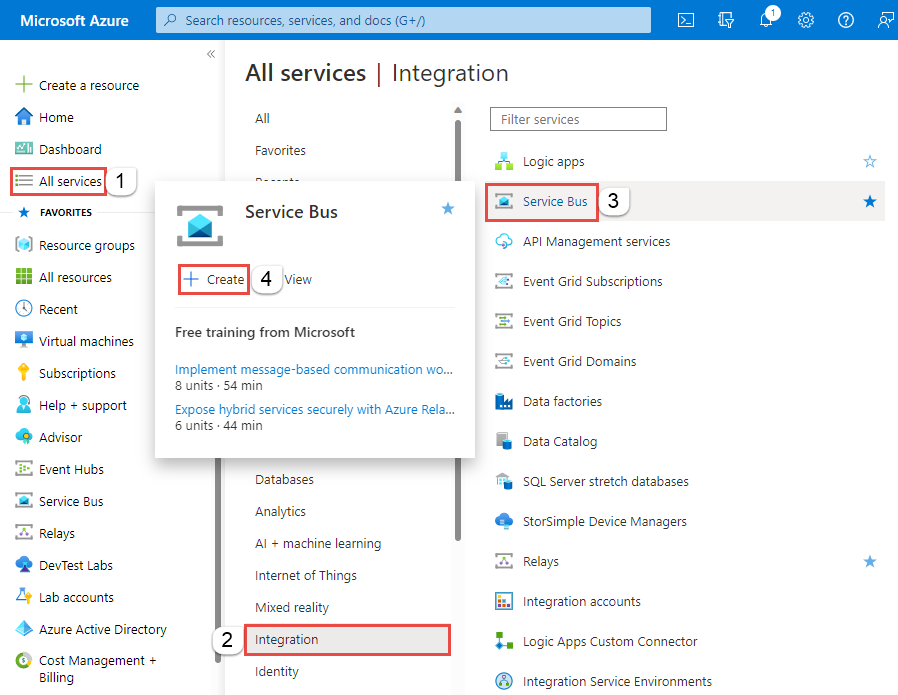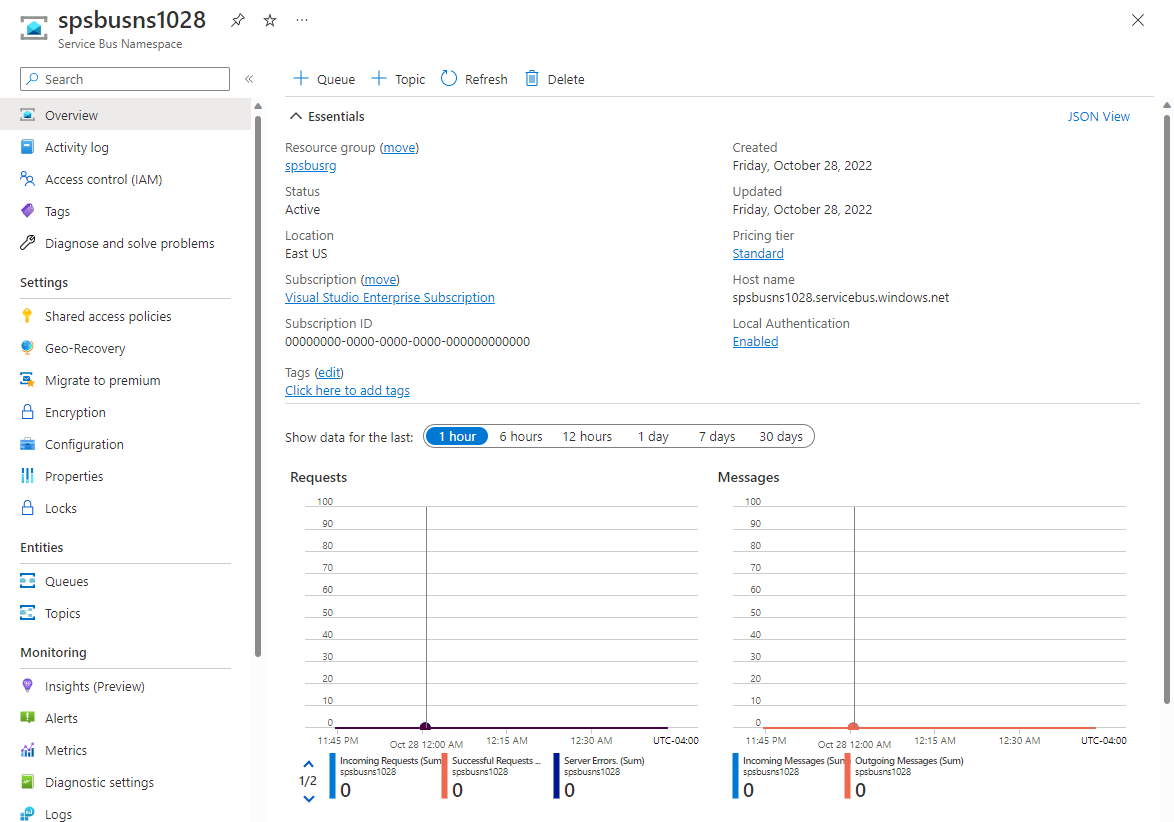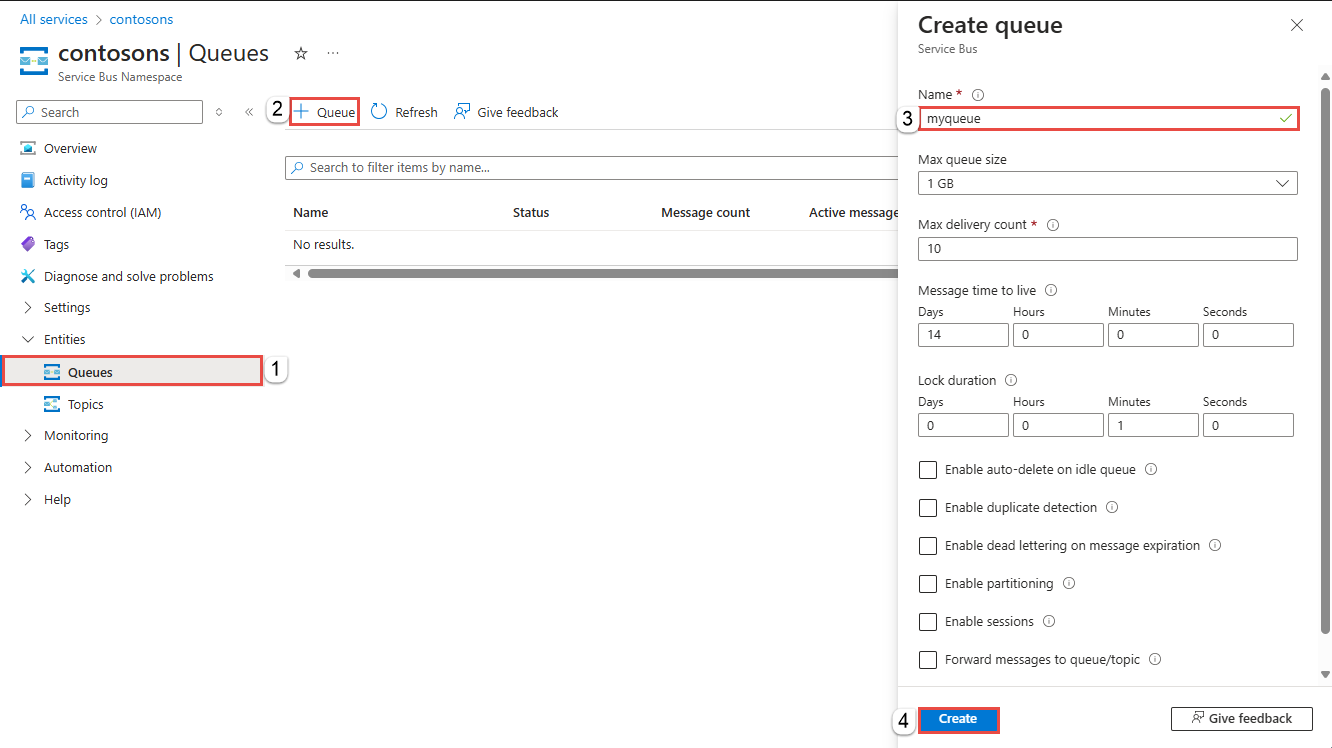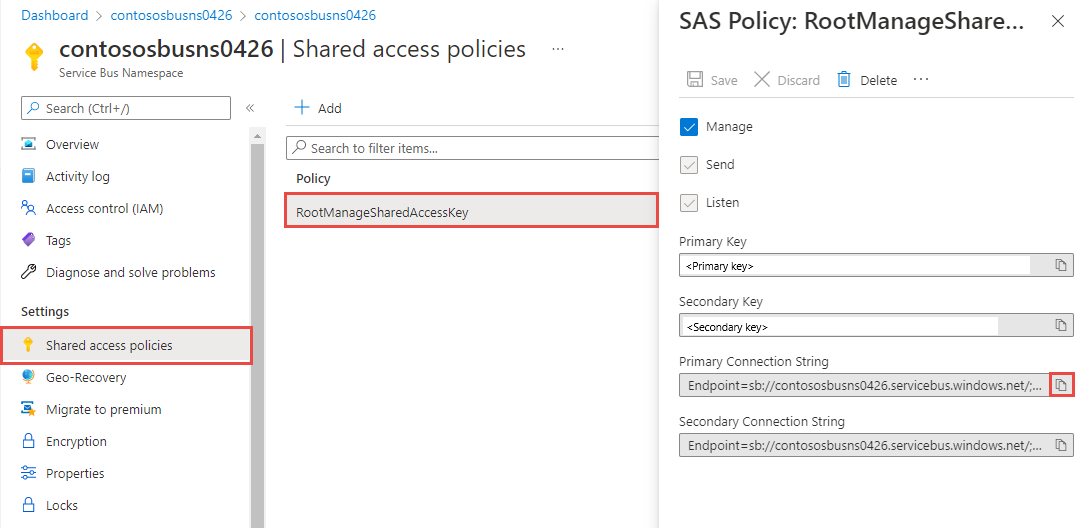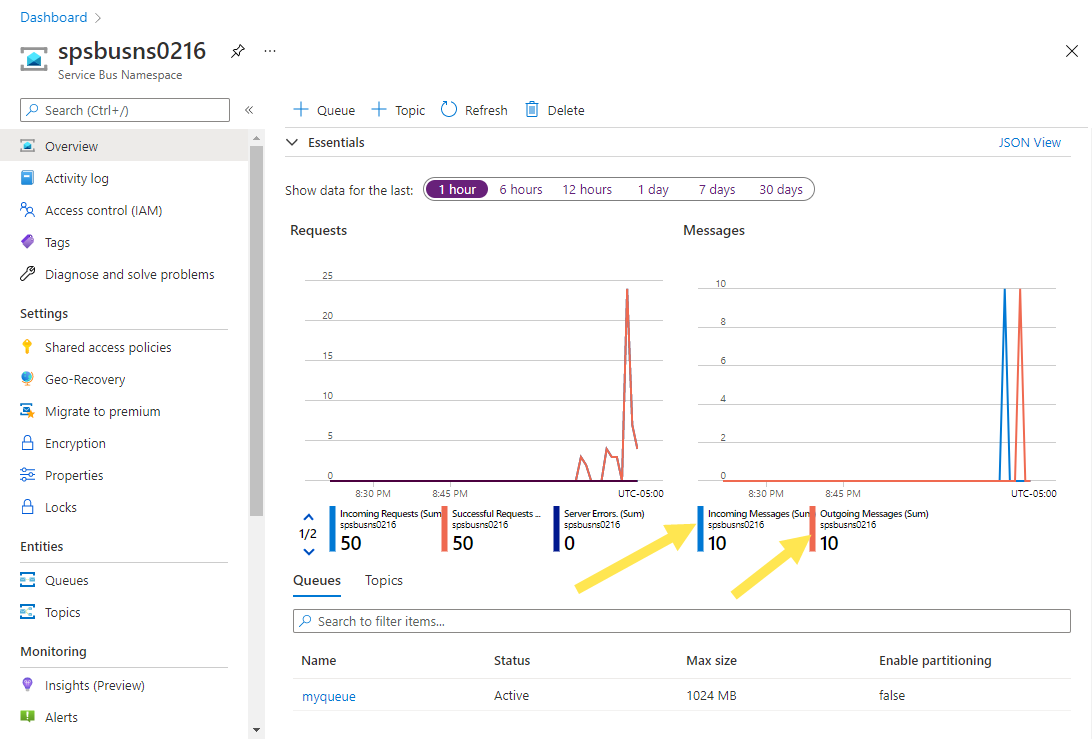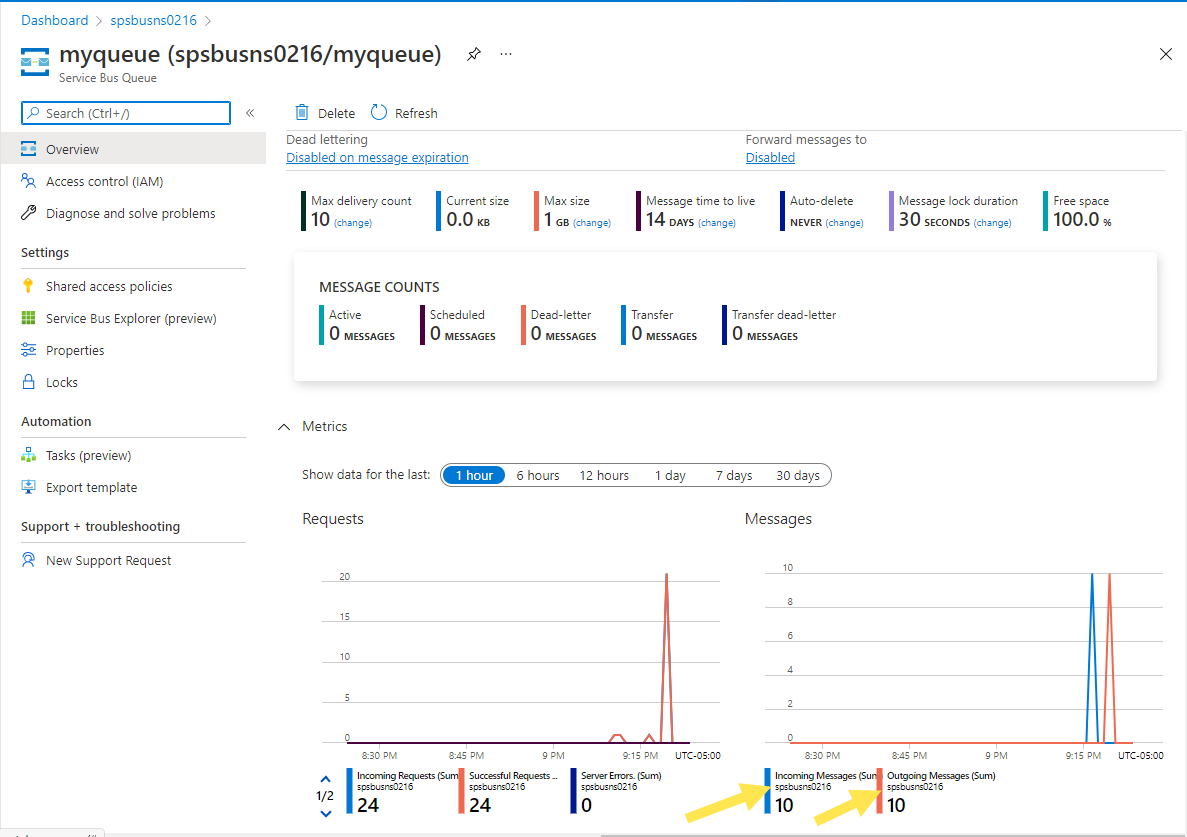本快速入门分步介绍了一个简单方案,也就是将消息发送到服务总线队列并接收这些消息。 在本快速入门中,你将完成以下任务:
使用 Azure 门户创建服务总线命名空间。
使用 Azure 门户创建服务总线队列。
编写 JavaScript 应用程序来使用 @azure/service-bus 包执行以下任务:
- 将一组消息发送到队列。
- 从队列接收这些消息。
可以在 GitHub 上的 Azure SDK for JavaScript 存储库中找到适用于 Azure 服务总线的预生成 JavaScript 和 TypeScript 示例。
如果不熟悉该服务,请参阅 服务总线概述 ,然后再开始。
先决条件
Azure 订阅。 若要完成本快速入门,需要一个 Azure 帐户。 可以激活 Visual Studio 订阅者的每月 Azure 额度 或注册 试用订阅。
通过自己的 Azure 帐户来使用本快速入门:
- 安装 Azure CLI,它提供向开发人员计算机进行无密码身份验证的功能。
- 在
az login的命令提示符下使用 Azure 帐户登录。 - 将适当的数据角色添加到资源时,请使用同一帐户。
- 在同一命令提示符窗口中运行代码。
- 请记下您的服务总线命名空间中的队列名称。 你需要在代码中包含它。
注意
本教程将演练可以使用 Nodejs 复制和运行的示例。 有关如何创建 Node.js 应用程序的说明,请参阅创建 Node.js 应用程序并将其部署到 Azure 网站或使用 Windows PowerShell 创建 Node.js 云服务。
在 Azure 门户中创建命名空间
若要开始使用 Azure 中的服务总线消息传送实体,请创建一个名称在 Azure 中唯一的命名空间。 命名空间为应用程序中的服务总线资源(例如队列和主题)提供范围容器。
创建命名空间:
登录 Azure 门户。
从左上角选择浮出控件菜单,然后导航到 “所有服务 ”页。
在左侧导航栏上,选择 “集成”。
向下滚动到 消息服务服务>总线 ,然后选择“ 创建”。
在“创建命名空间”页的“基本信息”选项卡中,执行以下步骤:
对于“订阅”,请选择要在其中创建命名空间的 Azure 订阅。
对于资源组,选择现有资源组或创建新的资源组。
输入符合以下命名约定的 命名空间名称 :
- 该名称在 Azure 中必须唯一。 系统会立即检查该名称是否可用。
- 名称长度最少为 6 个字符,最多为 50 个字符。
- 名称只能包含字母、数字、连字符
-。 - 名称必须以字母开头,并且必须以字母或数字结尾。
- 名称不以
-sb或-mgmt结尾。
对于 “位置”,请选择要托管命名空间的区域。
对于“定价层”,请选择命名空间的定价层(“基本”、“标准”或“高级”)。 对于本快速入门,请选择“标准”。
如果选择 “高级 ”层,则可以为命名空间启用 异地复制 。 异地复制功能可确保命名空间的元数据和数据从主要区域持续复制到一个或多个次要区域。
重要
若要使用主题和订阅,请选择“标准”或“高级”。 基本定价层不支持主题和订阅。
如果选择了“高级”定价层,请指定“消息传送单元”数 。 高级层在 CPU 和内存级别提供资源隔离,使每个工作负荷在隔离的环境中运行。 此资源容器称为 消息传送单元。 高级命名空间至少具有一个消息传送单元。 可为每个服务总线高级命名空间选择 1、2、4、8 或 16 个消息传送单元。 有关详细信息,请参阅 服务总线高级消息传送层。
在页面底部选择“查看 + 创建”。
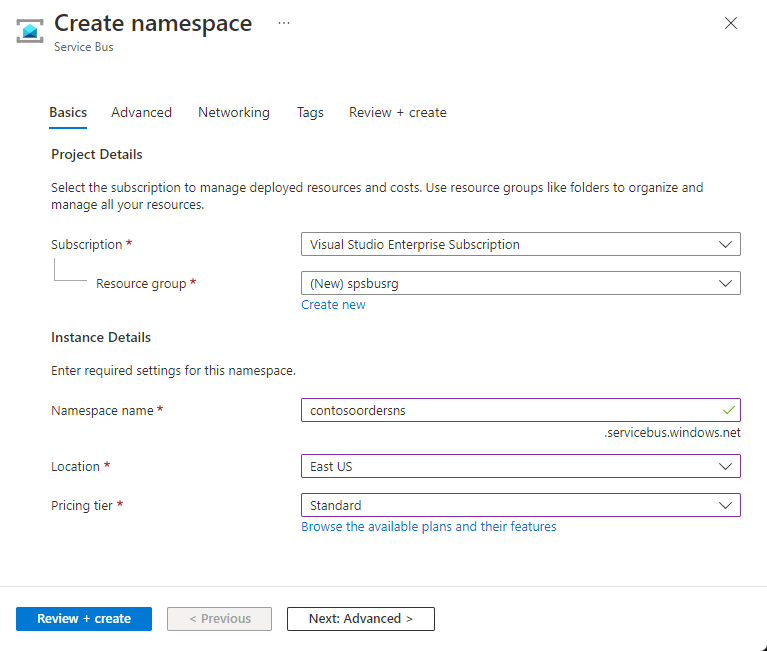
在“查看 + 创建”页上,查看设置,然后选择“创建” 。
部署资源成功后,在部署页上选择 “转到资源 ”。
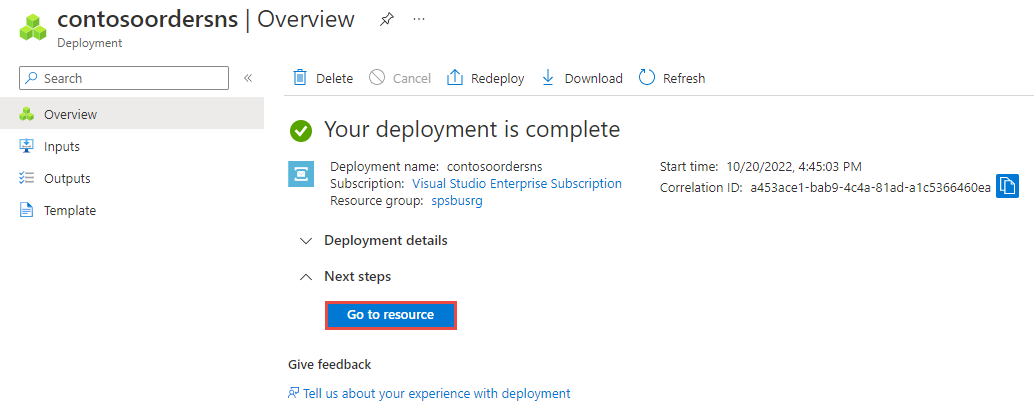
将会看到服务总线命名空间的主页。
在 Azure 门户中创建队列
向 Azure 验证应用
本文介绍连接到 Azure 服务总线的两种方法: 无密码 和 连接字符串。
第一个选项展示如何使用 Microsoft Entra ID 中的安全主体和基于角色的访问控制 (RBAC) 连接到服务总线命名空间。 无需担心在代码、配置文件或安全存储(如 Azure Key Vault)中具有硬编码连接字符串。
第二个选项展示如何使用连接字符串连接到服务总线命名空间。 如果不熟悉 Azure,你可能会感觉“连接字符串”选项更易于使用。 建议在实际应用程序和生产环境中使用无密码选项。 有关详细信息,请参阅 服务总线身份验证和授权。 若要详细了解无密码身份验证,请参阅 “对 .NET 应用进行身份验证”。
将角色分配给 Microsoft Entra 用户
在本地开发时,请确保连接到 Azure 服务总线的用户帐户具有正确的权限。 需要 Azure 服务总线数据所有者 角色才能发送和接收消息。 若要将此角色分配给自己,您需要 "User Access Administrator" 角色或其他包含 Microsoft.Authorization/roleAssignments/write 操作的角色。
可使用 Azure 门户、Azure CLI 或 Azure PowerShell 向用户分配 Azure RBAC 角色。 若要详细了解角色分配的可用范围,请参阅 了解 Azure RBAC 的范围。
以下示例将 Azure Service Bus Data Owner 角色分配给用户帐户,该角色提供对 Azure 服务总线资源的完全访问权限。 在实际方案中,遵循 最低特权原则 ,仅向用户授予更安全的生产环境所需的最低权限。
适用于 Azure 服务总线的 Azure 内置角色
对于 Azure 服务总线,通过 Azure 门户和 Azure 资源管理 API 对命名空间和所有相关资源的管理已使用 Azure RBAC 模型进行了保护。 Azure 提供了以下 Azure 内置角色,用于授予对服务总线命名空间的访问权限:
- Azure 服务总线数据所有者:允许数据访问服务总线命名空间及其实体,包括队列、主题、订阅和筛选器。 此角色的成员可以从队列或主题/订阅发送和接收消息。
-
Azure 服务总线数据发送方:使用此角色授予
send对服务总线命名空间及其实体的访问权限。 -
Azure 服务总线数据接收器:使用此角色授予
receive对服务总线命名空间及其实体的访问权限。
如果要创建自定义角色,请参阅执行服务总线操作所需的权限。
将 Microsoft Entra 用户添加到“Azure 服务总线所有者”角色
将 Microsoft Entra 用户名添加到服务总线命名空间级别的 Azure 服务总线数据所有者角色。 此配置允许在用户帐户上下文中运行的应用将消息发送到队列或主题。 它可以接收来自队列或主题订阅的消息。
重要
在大多数情况下,角色分配在 Azure 中传播需要一两分钟。 在极少数情况下,最多可能需要 8 分钟才能完成。 如果在首次运行代码时收到身份验证错误,请稍等片刻再试。
如果未在 Azure 门户中打开“服务总线命名空间”页,请使用主搜索栏或左侧导航找到你的服务总线命名空间。
在 “概述 ”页上,从左侧菜单中选择 “访问控制”(IAM )。
在“访问控制 (IAM)”页上,选择“角色分配”选项卡。
从顶部菜单中选择 “+ 添加” ,然后 添加角色分配。
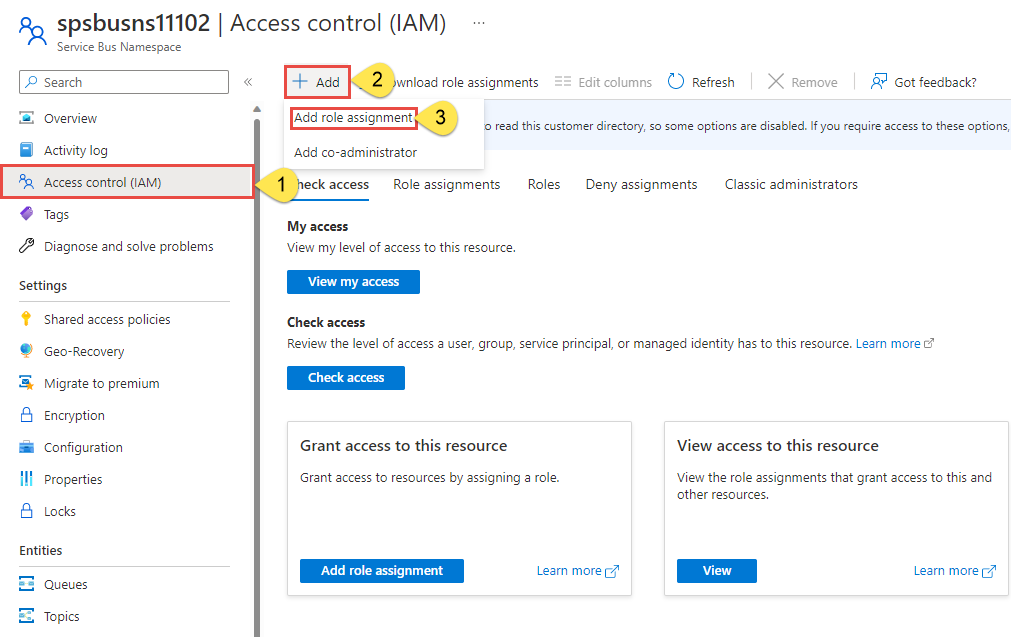
使用搜索框将结果筛选为所需角色。 对于此示例,请搜索
Azure Service Bus Data Owner并选择匹配的结果。 然后选择“下一步” 。在“访问权限分配对象”下,选择“用户、组或服务主体”,然后选择“+ 选择成员”。
在对话框中,搜索你的 Microsoft Entra 用户名(通常是你的 user@domain 电子邮件地址),然后在对话框的底部选择“选择”。
选择“查看 + 分配”转到最后一页,然后再次选择“查看 + 分配”完成该过程。
使用 Node 包管理器 (NPM) 安装包
若要安装服务总线所需的 npm 包,请打开其路径中的命令提示符窗口
npm,并将目录更改为要获取示例的文件夹。安装以下包:
npm install @azure/service-bus @azure/identity
向队列发送消息
以下示例代码演示如何向队列发送消息。
使用本地计算机的 Azure CLI 命令 az login 登录,以提供此代码中所需的无密码身份验证。
打开文本编辑器,如 Visual Studio Code。
创建名为
send.js的文件,然后将以下代码粘贴到其中。 此代码将科学家的名称作为消息发送到队列。重要
无密码凭据是使用 DefaultAzureCredential 提供的。
const { ServiceBusClient } = require("@azure/service-bus"); const { DefaultAzureCredential } = require("@azure/identity"); // Replace `<SERVICE-BUS-NAMESPACE>` with your namespace const fullyQualifiedNamespace = "<SERVICE-BUS-NAMESPACE>.servicebus.chinacloudapi.cn"; // Passwordless credential const credential = new DefaultAzureCredential(); // name of the queue const queueName = "<QUEUE NAME>" const messages = [ { body: "Albert Einstein" }, { body: "Werner Heisenberg" }, { body: "Marie Curie" }, { body: "Steven Hawking" }, { body: "Isaac Newton" }, { body: "Niels Bohr" }, { body: "Michael Faraday" }, { body: "Galileo Galilei" }, { body: "Johannes Kepler" }, { body: "Nikolaus Kopernikus" } ]; async function main() { // create a Service Bus client using the passwordless authentication to the Service Bus namespace const sbClient = new ServiceBusClient(fullyQualifiedNamespace, credential); // createSender() can also be used to create a sender for a topic. const sender = sbClient.createSender(queueName); try { // Tries to send all messages in a single batch. // Will fail if the messages cannot fit in a batch. // await sender.sendMessages(messages); // create a batch object let batch = await sender.createMessageBatch(); for (let i = 0; i < messages.length; i++) { // for each message in the array // try to add the message to the batch if (!batch.tryAddMessage(messages[i])) { // if it fails to add the message to the current batch // send the current batch as it is full await sender.sendMessages(batch); // then, create a new batch batch = await sender.createMessageBatch(); // now, add the message failed to be added to the previous batch to this batch if (!batch.tryAddMessage(messages[i])) { // if it still can't be added to the batch, the message is probably too big to fit in a batch throw new Error("Message too big to fit in a batch"); } } } // Send the last created batch of messages to the queue await sender.sendMessages(batch); console.log(`Sent a batch of messages to the queue: ${queueName}`); // Close the sender await sender.close(); } finally { await sbClient.close(); } } // call the main function main().catch((err) => { console.log("Error occurred: ", err); process.exit(1); });将
<SERVICE-BUS-NAMESPACE>替换为服务总线命名空间。将
<QUEUE NAME>替换为该队列的名称。若要运行此文件中的代码,请在命令提示符处使用此命令:
node send.js你会看到以下输出。
Sent a batch of messages to the queue: myqueue
从队列接收消息
使用本地计算机的 Azure CLI 命令 az login 登录,以提供此代码中所需的无密码身份验证。
打开文本编辑器,如 Visual Studio Code。
创建名为
receive.js的文件,然后将以下代码粘贴到其中。const { delay, ServiceBusClient, ServiceBusMessage } = require("@azure/service-bus"); const { DefaultAzureCredential } = require("@azure/identity"); // Replace `<SERVICE-BUS-NAMESPACE>` with your namespace const fullyQualifiedNamespace = "<SERVICE-BUS-NAMESPACE>.servicebus.chinacloudapi.cn"; // Passwordless credential const credential = new DefaultAzureCredential(); // name of the queue const queueName = "<QUEUE NAME>" async function main() { // create a Service Bus client using the passwordless authentication to the Service Bus namespace const sbClient = new ServiceBusClient(fullyQualifiedNamespace, credential); // createReceiver() can also be used to create a receiver for a subscription. const receiver = sbClient.createReceiver(queueName); // function to handle messages const myMessageHandler = async (messageReceived) => { console.log(`Received message: ${messageReceived.body}`); }; // function to handle any errors const myErrorHandler = async (error) => { console.log(error); }; // subscribe and specify the message and error handlers receiver.subscribe({ processMessage: myMessageHandler, processError: myErrorHandler }); // Waiting long enough before closing the sender to send messages await delay(20000); await receiver.close(); await sbClient.close(); } // call the main function main().catch((err) => { console.log("Error occurred: ", err); process.exit(1); });将
<SERVICE-BUS-NAMESPACE>替换为服务总线命名空间。将
<QUEUE NAME>替换为该队列的名称。若要运行此文件中的代码,请在命令提示符处使用此命令:
node receive.js
你会看到以下输出。
Received message: Albert Einstein
Received message: Werner Heisenberg
Received message: Marie Curie
Received message: Steven Hawking
Received message: Isaac Newton
Received message: Niels Bohr
Received message: Michael Faraday
Received message: Galileo Galilei
Received message: Johannes Kepler
Received message: Nikolaus Kopernikus
在 Azure 门户中的服务总线命名空间的“概述”页上,可看到传入和传出消息计数 。 可能需要等待一分钟左右,然后刷新页面以查看最新值。
在此“概述”页上选择队列,导航到“服务总线队列”页面 。 还可在此页上看到传入和传出消息计数 。 还可看到其他信息,如队列的当前大小、最大大小和活动消息计数等 。
疑难解答
如果在运行 JavaScript 代码的无密码 版本时收到以下错误之一,请使用 Azure CLI 命令 az login登录。
相应的角色应用于 Azure 用户帐户:
- 执行此操作需要“Send”声明
- 执行此操作需要“Receive”声明
清理资源
导航到 Azure 门户中的服务总线命名空间,然后在 Azure 门户上选择“删除”以删除命名空间及其中的队列。
相关内容
请参阅以下文档和示例:
